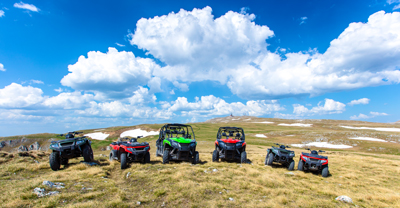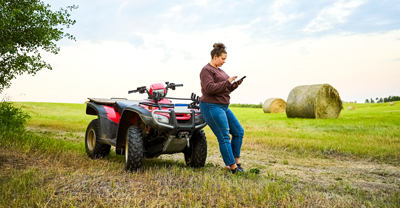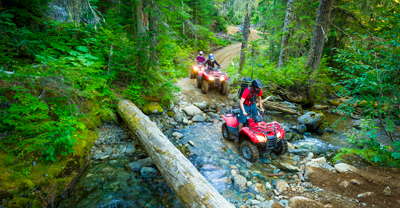7 exciting ATV innovations you need to know about
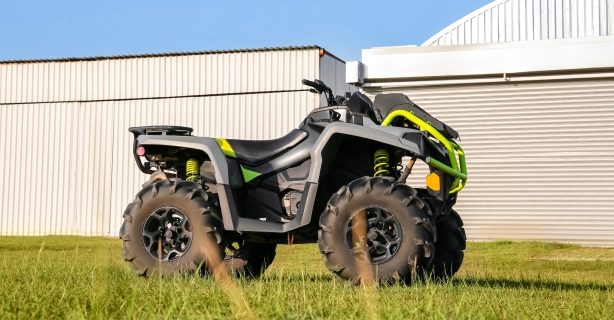
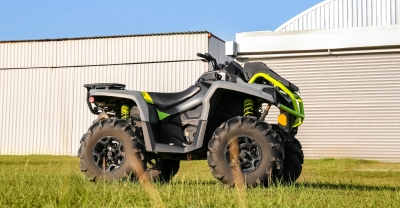
0 min. read
Riding an ATV is a thrilling way to explore the outdoors—but every trail comes with real risks. Remote terrain, unpredictable weather, and limited phone service can quickly turn a fun ride into a difficult situation.
Fortunately, ATV technology has come a long way in recent years, with new innovations designed to boost safety and performance. From wearable airbags to smart helmets, here are seven technologies improving the ATV riding experience.

Make sure your coverage is too—get your free off-road insurance quote today.
1. Electric ATVs
Electric ATVs are showing up on trails, farms, and work sites across the country. The technology has come a long way, but like any innovation, it comes with both advantages and limitations.
Why some riders choose electric ATVs:
Low noise and vibration, ideal for hunting, farm work, and eco-tourism
Simpler engines mean less maintenance
Reduced fire risk, especially in dry areas
No tailpipe emissions, making them a more eco-conscious option
Things to keep in mind:
Range is still limited, especially in rugged or cold environments
Higher upfront costs can be a barrier for some riders
Heavy-duty towing or high-performance riding may still be better suited for gas-powered machines
2. Collision prevention systems
Around 37% of ATV fatalities involve collisions, according to a report from the Consumer Product Safety Commission (CPSC).* To help address this, manufacturers and safety innovators are developing systems that give riders earlier warnings about potential hazards. This can be useful at any time, but especially in remote or unpredictable environments.
While you likely won’t find ATVs with built-in collision avoidance systems like you’d find in newer cars—think automatic emergency braking—there are some aftermarket systems available.
Many kits use sensors or cameras to alert riders of obstacles. Most of these systems are warning only, meaning they won’t stop your ATV automatically. For riders who want more visibility, particularly newer riders or those heading off-trail, these systems can be a smart safety upgrade.
3. Electronic stability control (ESC)
Electronic stability control technology has started to make its way from cars to ATVs over the past few years. Around 2022, researchers began testing versions specifically tailored for off-road vehicles. Using sensors to monitor movement, ESC can adjust throttle or apply brakes to help keep the machine steady. Early tests seem to be promising, but as of now the technology only exists as a proof of concept.
That said, some newer ATVs offer anti-lock braking systems (ABS). Although it isn’t as advanced as ESC, ABS can help prevent wheel lockups during braking which can give riders better overall control.
4. Smart helmets
Helmets have always been essential safety gear. Now, technology is taking them to the next level with smart helmets—head protection with added communication, navigation, and safety features.
What smart helmets can offer:
Heads-up displays (HUDs) so you can check navigation without looking down
Bluetooth communication for group rides and hands-free calls
Crash detection sensors that can notify emergency services after an impact
These features have made smart helmets popular with motorcyclists, and ATV riders are beginning to adopt them as well. Still, they come with a few considerations:
Smart helmets often rely on a strong cellular connection
Off-road conditions like water, dirt, and dust can affect their performance
They can cost anywhere from a few hundred dollars to more than $1,000
Not interested in high-tech gear? A DOT-approved off-road helmet remains one of the most effective ways to stay protected on the trail.
5. Night vision and thermal cameras
Riding after sunset or in low-visibility conditions often comes with added risks. To address this, some ATV manufacturers are beginning to experiment with infrared and thermal detection systems—technology that helps riders spot obstacles in the dark or through poor weather.
While the technology is still not standard, aftermarket thermal and infrared devices are available. These cameras are often mounted to the ATV or helmet and can help extend rider visibility. A few select systems can even be integrated into the vehicle to provide alert or braking features. That said, don’t be surprised to spend anywhere from $1,500 to $5,000 for a setup.
If night vision cameras are outside your budget—or if you ride in areas where simple lighting upgrades are enough—LED light bars, auxiliary lamps, and upgraded headlamps can greatly improve visibility compared to older halogen lights.

Get your free off-road insurance quote now.
6. Rollover protection
Rollover accidents remain one of the most serious dangers for ATV riders. In fact, a 2023 CPSC report found that 65% of ATV fatalities involved rollovers.* Because of this, manufacturers and safety experts are working on new ways to protect riders if a rollover happens.
Some ATVs now come equipped with occupant protection devices (OPDs)—rigid bars designed to reduce the risk of crush injuries during a rollover. Building off of this concept, researchers are testing integrated airbags within ATV frames. It’s still in the proof-of-concept stage but is showing early promise.
For riders seeking added protection today, airbag vests and backpacks are available on the market. These wearable devices deploy on impact to help protect the chest and spine, with most models priced between $400 to $1,000 depending on brand and style.
7. Integrated GPS features
GPS isn’t just about navigation anymore—it’s also becoming a safety tool for ATV riders. Some manufacturers now include integrated GPS features that allow you to set speed limits, create geofences to keep younger riders within safe boundaries, and track or review routes to monitor progress or share trails.
If your ATV doesn’t come with GPS, there are plenty of aftermarket units designed for off-road use. Many focus on navigation only, but they can be especially valuable in areas where cell service is unreliable.
Safe riding still comes first
Even the most advanced technology can’t prevent every accident. That’s why safe riding practices and proper training remain your first line of defense. Here are a few tips to help reduce risk of injury or an accident:
Safety gear: Anytime you go out on a ride, wear the appropriate safety gear, including a helmet, goggles, and gloves.
Lean with the ATV: Shifting your body weight during turns and elevation changes can help prevent rollovers.
No extra passengers: Unless your ATV is specifically designed for an extra passenger, adding one can change balance and increase rollover risk.
For added peace of mind or if it’s required in your state, consider an off-road insurance policy. Coverage can help offset costs related to vehicle repairs or medical expenses if an accident occurs.
Dairyland®, a brand of the Sentry Insurance Group, provides affordable and flexible off-road insurance options. Contact us today.

Get coverage that keeps up—start your free quote now.
The general information in this blog is for informational or entertainment purposes only. View our blog disclaimer.
*Data accuracy is subject to this article’s publication date.








